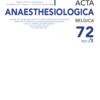A comparative study of transdiscal versus transaortic celiac plexus neurolytic block for upper gastrointestinal cancer patients. A prospective, randomized control study
Celiac plexus block; transaortic approach; transdiscal approach; WHOQOL-BREF score; VAS score; upper GI malignancies
Published online: Mar 29 2022
Abstract
Aim: To compare transdiscal and transaortic techniques of neurolytic celiac plexus block for upper gastrointestinal cancer patients.
Methods: In this prospective randomized study 60 patients with upper gastrointestinal malignancies were included and randomly divided into two groups, group TD and group TA, receiving neurolytic celiac plexus blocks via transdiscal and transaortic techniques, respectively. The primary outcome was quality of life (QoL) as assessed by WHOQOL BREF questionnaire and secondary outcomes were pain relief using visual analogue scale (VAS), and occurrence of complications like hypotension, loose motion, bleeding and discitis.
Result: QoL and VAS score were significantly improved in both groups post procedure. Transdiscal approach is more effective in improving VAS score than transaortic approach (1 vs 3) after 1 week and the relief of pain was better in TD group (3 vs 6) at the end of 2 months. Transdiscal approach was found to be more effective in improving QoL (227.00±28.85 vs 191.17±35.78) as compared to transaortic approach. However, post-procedural QoL improved in both groups when compared to pre-procedural QoL (p<0.05). Hypotension, diarrhea and bleeding from aorta were higher in TA group; however, no serious complications were seen in any of the groups.
Conclusion: Transdiscal technique is better in terms of adequate pain relief and improving QoL as compared to transaortic technique of NCPB in patients of upper GI malignancies and is associated with lesser incidences of complications.
